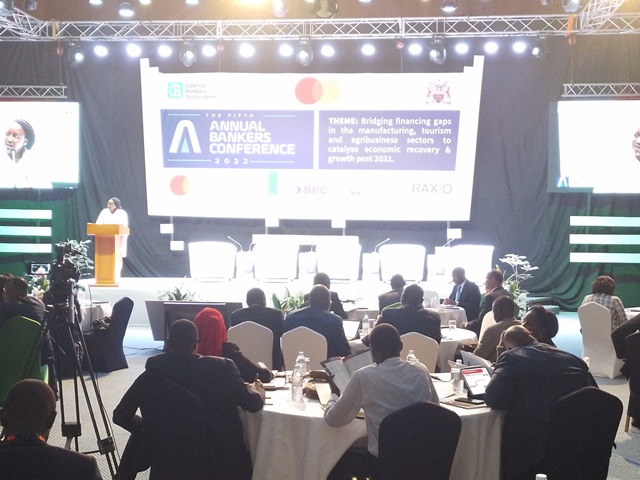African manufacturing needs large and patient outlay to take off, Afreximbank tells Uganda bankers
 Ministry of Tradeand Cooperatives PS Geraldine Ssali, speaking at the Annual Bankers Conference 2021
Ministry of Tradeand Cooperatives PS Geraldine Ssali, speaking at the Annual Bankers Conference 2021
Unlocking Uganda’s tourism and manufacturing potential will require strategic policy moves, and a shift by lenders away from a pervasive mindset that sees lending to manufacturing as too risky, to a more accommodative stance.
SME’s, which account for 93.5pc of firms in manufacturing face a huge funding deficit, as lenders bet safe on the larger, more established players.
Delivering the keynote address to this year’s edition of the Annual Bankers Conference, on the role of financial institutions in bridging financing gaps in the manufacturing and tourism sectors July25, Hippolyte Fofack, director and chief economist at director for research at the African Import-Export Bank Afreximbank, said that despite their potential, the contribution of tourism and manufacturing to Africa’s GDP remained marginal.
On average, manufacturing contributed just 12pc of Africa’s GDP in 2021, compared to 25pc in Asia. Part of the reason is under investment in the sector, which in Uganda’s case, has translated into a USD 8.8 billion financing gap for SME’s, Fofack revealed.
He attributed that to tunnel vision by lenders in emerging markets who tend to see the fewer, but larger manufacturing establishments – accounting for just about 1pc of the sector- as safer bets for credit. In Uganda for instance, manufacturing’s share of total lending dropped from 14.1pc in 2007 to 13.1pc in 2021, showing that even pre-Covid, lenders appetite for the sector was low.
To turn the tide Fofack advocates a policy approach that nudges lenders out of the comfort zone of government securities and overcoming “the institutional culture which assumes that lending to the manufacturing sector is too risky.”
He gave the example of the Central Bank of Nigeria, which in December 2019, took the bull by the horns, setting a minimum loan-to-deposit-ratio threshold of 65pc to check lenders appetite for government securities. The move triggered a 40pc increase in lending to the private sector, even though that came with an attendant rise in the non-performing loans portfolio.
He cautioned against high lending rates to the sector – 18pc in Uganda and 15.5pc in Nigeria, which he said set unrealistic expectations of returns that often set the stage for default. The sector needs a large pool of patient capital, which Afreximbank is providing by matching each dollar committed to the sector by a factor of eight.
African economies need to find a new development paradigm by effecting a transition from the colonial development model, which was based on resource extraction to one that focuses on participation in global supply chains, Fofack advised.
“Manufacturing will accelerate structural transformation and support inclusive growth in Africa,” Fofack said but that will require policy incentives and lenders adopting a longer-term view of manufacturing.
Because manufacturing is integral to macro-economic stability, banks that support economic growth by lending to manufacturing also tend to enjoy more growth over the long-run curve, he added.

 African Heads of state head to South Korea next week for Summit talks
African Heads of state head to South Korea next week for Summit talks
 Trading leads as main source of income for Ugandans
Trading leads as main source of income for Ugandans
 New leadership for bankers’ umbrella as total assets top $12 billion
New leadership for bankers’ umbrella as total assets top $12 billion
 Brussels Airlines to announce Nairobi service
Brussels Airlines to announce Nairobi service
 SITA promises enhanced travel experience after Materna acquisition
SITA promises enhanced travel experience after Materna acquisition
 Saudia’s 105 aircraft order stretches A320neo lead over rival Max
Saudia’s 105 aircraft order stretches A320neo lead over rival Max
